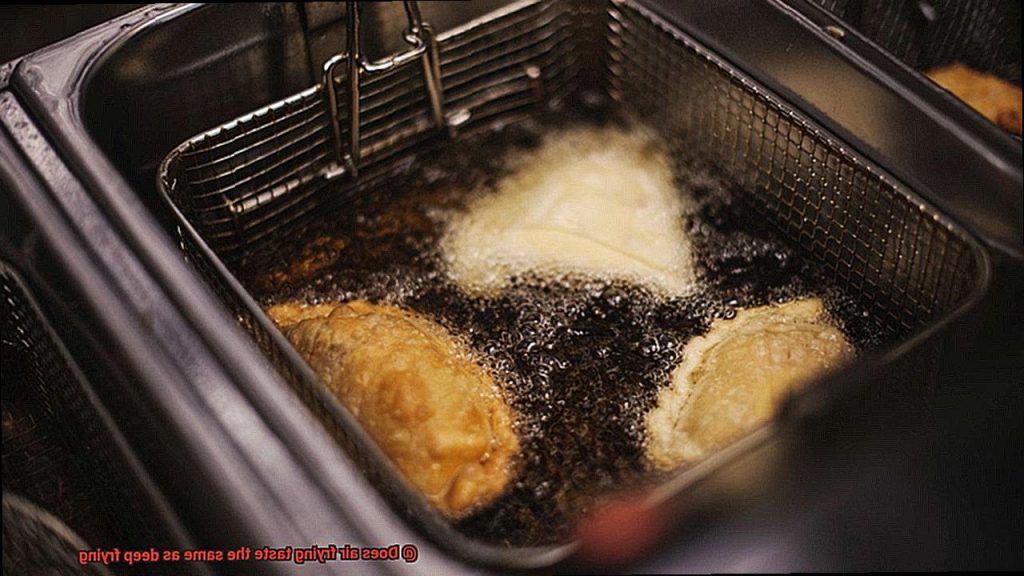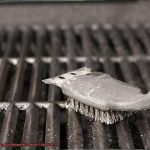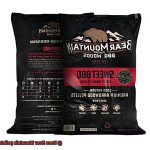Do you have a soft spot for fried food, but feel guilty about the unhealthy consequences? Are you constantly craving the crispy texture of deep-fried food, but avoid it like the plague to cut down on your oil intake? Well, take heart – air fryers are here to save the day. They claim to provide the same taste and texture as deep-fried food with much less oil. But hold on a minute: Does air frying really measure up to deep frying when it comes to flavor?
Before we dive into this topic, let’s first understand what air frying is. Essentially, air frying involves circulating hot air around the food until it reaches a crispy texture similar to deep frying. On the other hand, deep frying involves cooking food submerged in hot oil until it turns golden brown and crunchy.
While some people swear by air frying as an excellent substitute for deep frying, others argue that nothing can replace the irresistible flavor of traditional fried food. While both methods create a crispy texture, several factors such as cooking time, seasoning, and type of food can impact the taste comparison.
In this blog post, we’ll explore the differences between air frying and deep frying and examine whether or not air frying can match up to its counterpart in terms of taste. So stick around and let’s find out if you can indulge in your favorite fried foods without compromising your health.
Contents
Benefits of Air Frying Compared to Deep Frying
Look no further than air frying. This cooking method has become increasingly popular in recent years due to the numerous benefits it offers compared to traditional deep frying.
First and foremost, air frying is much healthier than deep frying. By using hot air instead of oil, air fryers significantly reduce the amount of fat and calories in your food. This means you can indulge in crispy fried dishes without compromising your health.
But that’s not all – air frying is also incredibly convenient. Unlike deep frying, which requires a lot of oil and can be messy, air frying requires little to no oil and is much easier to clean up. This makes it the perfect option for busy individuals who want to cook healthy meals quickly and without hassle.
And let’s not forget about taste – air frying produces food that is just as crispy and delicious, if not more so, than deep-fried foods. With rapid air technology, hot air circulates around the food, creating a crispy exterior while keeping the inside tender and juicy.
So, the benefits of air frying are numerous:
- Healthier cooking method with less fat and calories
- Convenient and easy to use with little to no mess
- Produces crispy and delicious food
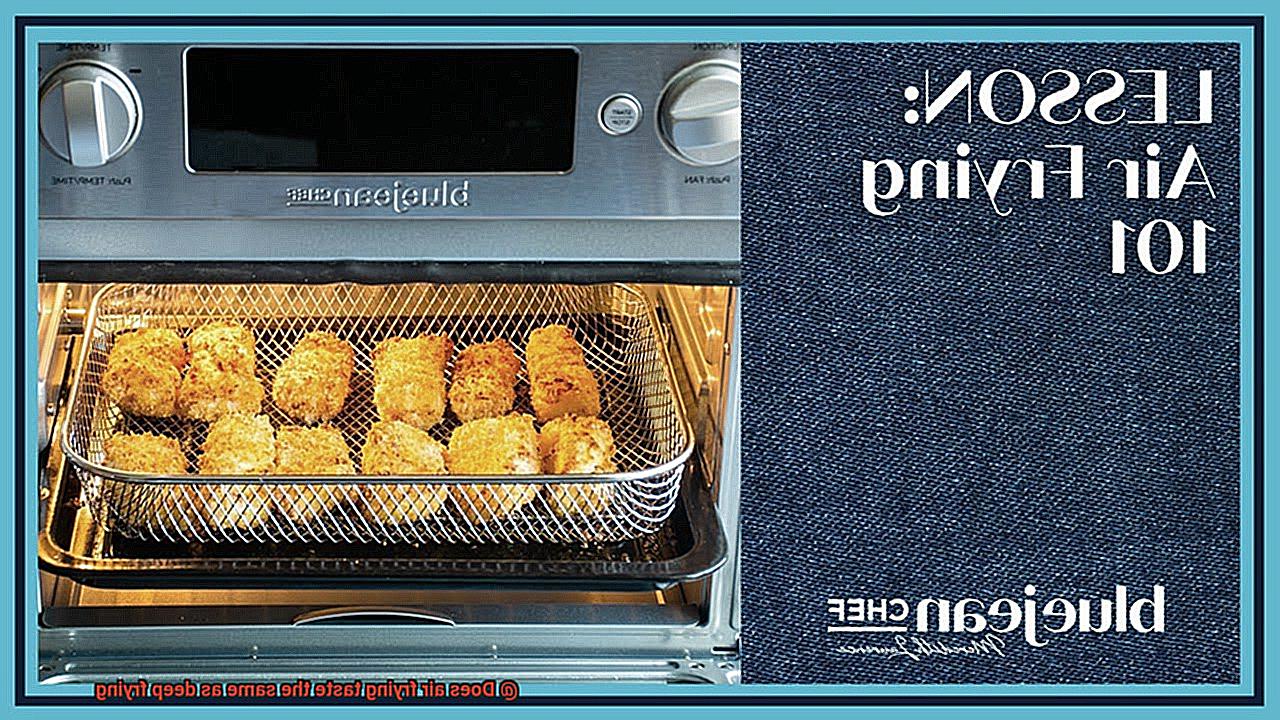
Understanding the Maillard Reaction in Deep Frying
Well, the secret to their irresistible taste and texture lies in the Maillard reaction. This is a chemical reaction that occurs when heat is applied to food, resulting in a deliciously crispy exterior and juicy interior.
But did you know that the Maillard reaction can be affected by the temperature and type of oil used in deep frying? Let’s dive a little deeper into this fascinating science.
Temperature plays a crucial role in deep frying. For the Maillard reaction to take place, oil needs to be heated to temperatures up to 375°F (190°C) or higher. This high heat allows for the reaction to occur rapidly, creating that signature crispy texture we all crave. However, in air frying, the temperature is typically around 400°F (200°C) or lower. This lower temperature may not allow for the same rapid Maillard reaction to occur, resulting in food that isn’t as crispy.
But it’s not just temperature that affects the Maillard reaction; the type of oil used also plays a vital role. Oils with a higher smoke point, such as vegetable or peanut oil, are typically used in deep frying because they can withstand high temperatures without breaking down. In air frying, however, oils with a lower smoke point may be used, which can affect the Maillard reaction because these oils may not allow for the same level of heat to be applied to the food.
So, what does this all mean for your taste buds? While air frying can produce similar results to deep frying in terms of taste and texture, it may not provide the same level of Maillard reaction that deep frying does. However, air frying is still a healthier option since it significantly reduces the amount of fat and calories in your food.
The Crispy Taste of Deep Frying vs. Air Frying
You may have heard of air-frying as a healthier alternative. But how do these two methods stack up when it comes to taste, texture, and health benefits?
Let’s start with deep-frying. This classic cooking technique involves submerging food in hot oil, resulting in a crispy exterior and juicy interior. However, deep-frying can also lead to greasy and unhealthy food. The high temperature of the oil triggers the Maillard reaction, which creates that irresistible golden color and delicious flavor. But the downside is that deep-fried food can be heavy and dense, making it difficult to digest and leaving us feeling sluggish.
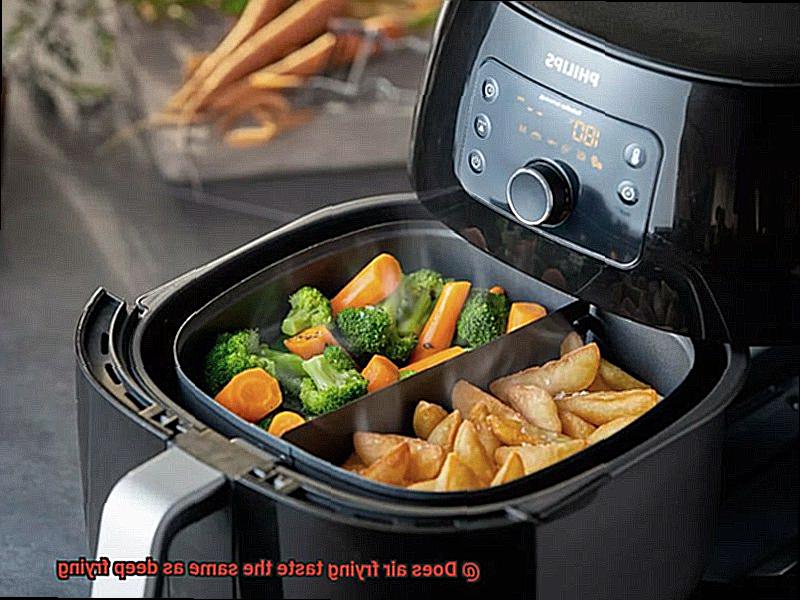
On the other hand, air-frying uses hot air to create a similar crispy texture without the need for excessive oil. This makes it an attractive option for those looking to reduce their calorie and fat intake while still enjoying their favorite fried foods. Air-fried food tends to have a lighter and more delicate texture compared to deep-fried food. It also has less grease, giving it a cleaner taste and making it easier on the stomach.
So how does air-fried food compare in terms of taste? Some people argue that nothing beats the rich and satisfying flavor of deep-fried food. The lack of oil in air frying can result in a less flavorful exterior, leaving some palates unsatisfied. However, others enjoy the lighter taste of air-fried food, which allows them to savor the flavors of the ingredients without being overwhelmed by grease.
Finally, in terms of health benefits, air-frying wins out over deep frying. By reducing the amount of oil used in cooking, air-frying can significantly lower calorie and fat content. This makes it a great option for those looking to maintain a healthy diet without sacrificing taste.
Cooking Different Foods with Air Frying
If you’re looking for a healthier way to cook your favorite fried foods, look no further than air frying. This cooking method uses hot air to cook food, resulting in less grease and fewer calories. Plus, air frying is incredibly versatile and can be used to cook a wide variety of dishes, from chicken wings to vegetables and even desserts.

To get the most out of your air fryer, it’s important to adjust the temperature and cooking time based on the food you’re preparing. For example, if you’re making chicken wings, preheat your air fryer to 375°F and cook them for 20 minutes. Remember to flip them halfway through cooking to ensure even crispness and check the internal temperature with a meat thermometer to ensure they’re fully cooked.
But it’s not just savory dishes that can be cooked in an air fryer. Vegetables like Brussels sprouts can also be made crispy and delicious in an air fryer. Simply preheat your air fryer to 400°F and cook them for 10-15 minutes, shaking the basket occasionally to ensure even browning.
In addition to being a healthier alternative to deep frying, air frying is also faster and more convenient. There’s no need for messy oil or long preheating times, making it a great option for busy weeknights or entertaining guests.
Pros and Cons of Air Frying
Air frying might just be the answer. This cooking method circulates hot air around the food, resulting in a crispy exterior while keeping the interior moist and tender. While air frying has many benefits, there are also some drawbacks to consider.
Let’s start with the pros. Firstly, air frying is a healthier option than deep frying. By using significantly less oil, you can reduce the fat content of your food by up to 80%. This makes it an excellent choice for those who are health-conscious or have dietary restrictions. Secondly, air fryers are incredibly convenient. They require little to no preheating time and eliminate the need for messy cleanups that come with deep frying. Lastly, air fryers are versatile kitchen appliances that can be used to cook a wide variety of foods, from vegetables to meats and even desserts.
However, there are also some cons to air frying. Firstly, air fryers have smaller cooking baskets compared to deep fryers, which means they can only cook small portions at a time. This can be inconvenient if you’re cooking for a larger group of people or want to make a bigger batch of food. Secondly, depending on the type of food you’re cooking, air fryers may not distribute heat evenly, resulting in some parts being overcooked while others remain undercooked. Lastly, air fryers can be more expensive than traditional deep fryers.
Tips for Achieving the Best Results with Air Frying
Air frying has become a popular and healthier alternative to deep frying, but achieving the best results can require some tips and tricks. Here are five sub-sections of tips to help you get the most out of your air fryer.
Preheat and Use the Right Temperature
Preheating your air fryer is crucial to ensure that your food cooks evenly and crisps up nicely. Different foods require different temperatures for optimal cooking, so be sure to follow the recipe or guidelines. Using the right temperature will prevent your food from burning or undercooking, resulting in a perfect dish every time.
Use the Right Amount of Oil
While air frying uses less oil than deep frying, it is still important to use enough oil or cooking spray to help with browning and prevent sticking. Using too little oil can result in dry, unappetizing food, while too much oil can make the food soggy or greasy. Experiment with different oils or cooking sprays to find what works best for you.
Shake and Don’t Overcrowd the Basket
Shaking the basket during cooking helps ensure that all sides of the food are evenly cooked and crispy. It’s also important not to overcrowd the basket, as this can lead to uneven cooking and soggy food. Leave enough space between items for air to circulate and cook in batches if necessary.
Flip or Shake Your Food
Flipping or shaking your food halfway through the cooking process ensures that all sides are evenly cooked and crispy. This can be done using tongs or a spatula. It’s essential to flip or shake your food for even cooking results.
Experiment with Seasonings
Air frying can still provide a similar taste to deep frying, but it may require some additional seasoning or dipping sauces. Try experimenting with different seasonings and spices to add flavor to your food. You’ll be surprised at how much flavor you can add to your dish with a few simple spices.
Common Mistakes to Avoid When Using an Air Fryer
So, you’ve got a brand new air fryer, and you’re excited to cook up some delicious and healthy meals. But, before you get started, it’s important to know the common mistakes to avoid for perfect results every time.
First off, overcrowding the air fryer basket is a big mistake. It might seem like a good idea to cram as much food as possible in there, but this can lead to uneven cooking and a soggy texture. Make sure there is enough space between each food item to allow for proper air circulation and even cooking.
Another mistake is not preheating the air fryer. This step may seem minor, but preheating allows the air fryer to reach the desired temperature before cooking. This results in a crispier texture that everyone loves. Don’t forget to preheat your air fryer before cooking.
When it comes to oil, using too much or using the wrong type can also impact the taste and texture of your food. Use high smoke point oils such as avocado or peanut oil in small amounts to prevent a greasy texture.
Last but not least, adjusting the cooking time and temperature for different types of food is vital for optimal outcomes. Follow recipe guidelines and adjust accordingly based on personal preferences and the specific ingredients used.
To summarize:
- Avoid overcrowding the air fryer basket
- Preheat your air fryer before cooking
- Use high smoke point oils in small amounts
- Adjust cooking time and temperature for different types of food
_STJoxd9mxk” >
Conclusion
In summary, air frying is a healthier and more convenient alternative to deep frying that can produce similar taste and texture results. By using hot air instead of oil, air fryers significantly reduce the amount of fat and calories in food while still providing a crispy exterior. However, it’s important to note that factors such as cooking time, seasoning, and type of food can impact the taste comparison between air frying and deep frying.
The Maillard reaction is what creates the irresistible taste and texture of deep-fried food. Temperature and type of oil used in deep frying can affect this reaction, which may not occur at the same level in air frying due to its lower temperature and use of oils with lower smoke points. Nevertheless, air-fried food usually has a lighter and more delicate texture compared to deep-fried food.
Air frying is also faster, more convenient, and versatile than traditional deep frying. Achieving the best results with air frying involves preheating the fryer, using the right amount of oil or cooking spray, shaking or flipping the food during cooking, experimenting with seasonings, and avoiding common mistakes such as overcrowding the basket.
In conclusion, if you’re seeking a healthier way to cook your favorite fried foods without sacrificing on taste or texture, air frying is an excellent option worth considering.

